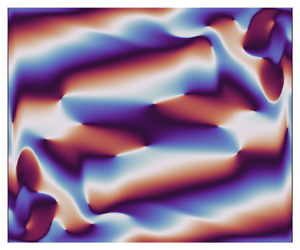No CrossRef data available.
Article contents
Vertical convection regimes in a two-dimensional rectangular cavity: Prandtl and aspect ratio dependence
Published online by Cambridge University Press: 16 February 2024
Abstract

Vertical convection is the fluid motion that is induced by the heating and cooling of two opposed vertical boundaries of a rectangular cavity (see e.g. Wang et al., J. Fluid Mech., vol. 917, 2021, A6). We consider the linear stability of the steady two-dimensional flow reached at Rayleigh numbers of O( $10^8$). As a function of the Prandtl number,
$10^8$). As a function of the Prandtl number,  $Pr$, and the height-to-width aspect ratio of the domain,
$Pr$, and the height-to-width aspect ratio of the domain,  $A$, the base flow of each case is computed numerically and linear simulations are used to obtain the properties of the leading linear instability mode. Flow regimes depend on the presence of a circulation in the entire cavity, detachment of the thermal layer from the boundary or the corner regions and on the oscillation frequency relative to the natural frequency of oscillation in the stably temperature-stratified interior, allowing for the presence of internal waves or not. Accordingly, the regime is called slow or fast, respectively. Either the global circulation or internal waves in the interior may couple the top and bottom buoyancy currents, while their absence implies asymmetry in their perturbation amplitude. Six flow regimes are found in the range of
$A$, the base flow of each case is computed numerically and linear simulations are used to obtain the properties of the leading linear instability mode. Flow regimes depend on the presence of a circulation in the entire cavity, detachment of the thermal layer from the boundary or the corner regions and on the oscillation frequency relative to the natural frequency of oscillation in the stably temperature-stratified interior, allowing for the presence of internal waves or not. Accordingly, the regime is called slow or fast, respectively. Either the global circulation or internal waves in the interior may couple the top and bottom buoyancy currents, while their absence implies asymmetry in their perturbation amplitude. Six flow regimes are found in the range of  $0.1 \leq Pr \leq 4$ and
$0.1 \leq Pr \leq 4$ and  $0.5 \leq A \leq 2$. For
$0.5 \leq A \leq 2$. For  $Pr \lessapprox 0.4$ and
$Pr \lessapprox 0.4$ and  $A>1$, the base flow is driven by a large circulation in the entire cavity. For
$A>1$, the base flow is driven by a large circulation in the entire cavity. For  $Pr \gtrapprox 0.7$, the thermal boundary layers are thin and the instability is driven by the motion along the wall and the detached boundary layer. A transition between these regimes is marked by a dramatic change in oscillation frequency at
$Pr \gtrapprox 0.7$, the thermal boundary layers are thin and the instability is driven by the motion along the wall and the detached boundary layer. A transition between these regimes is marked by a dramatic change in oscillation frequency at  $Pr = 0.55 \pm 0.15$ and
$Pr = 0.55 \pm 0.15$ and  $A <2$.
$A <2$.
JFM classification
- Type
- JFM Papers
- Information
- Copyright
- © The Author(s), 2024. Published by Cambridge University Press





